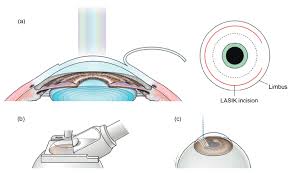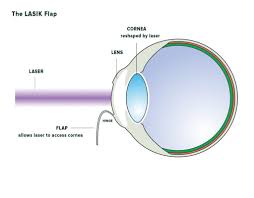Table of Contents
ToggleDeciding whether LASIK eye surgery is a viable option for those with type 2 diabetes can feel like navigating a complex maze.
Many in the diabetic community, as well as health-conscious individuals and eye care seekers, ponder this question.
This blog post aims to shed light on this topic and provide clarity on whether you can undergo LASIK if you have type 2 diabetes.
Understanding LASIK
First, let’s briefly explain what LASIK is. LASIK (Laser-Assisted In Situ Keratomileusis) is a popular eye surgery that corrects vision issues such as myopia (nearsightedness), hyperopia (farsightedness), and astigmatism. The procedure involves reshaping the cornea using a laser, which helps light focus correctly on the retina, resulting in clearer vision.
The Impact of Type 2 Diabetes on Eye Health
Type 2 diabetes can have various effects on eye health, potentially complicating the decision to undergo LASIK:
- Fluctuating Blood Sugar Levels: Unstable blood sugar levels can lead to fluctuating vision, making it difficult to achieve optimal results from LASIK. High blood sugar levels over time can lead to complications such as diabetic retinopathy, cataracts, and glaucoma.
- Diabetic Retinopathy: This common complication of diabetes affects the blood vessels in the retina, potentially impacting the safety and success of LASIK.
- Healing and Infection Risks: Diabetes can slow the healing process and increase the risk of infections, both of which are crucial considerations for any surgical procedure.
Can You Get LASIK with Type 2 Diabetes?
The short answer is that it depends. While having type 2 diabetes does not automatically disqualify you from getting LASIK, several factors need to be considered:
1. Stable Blood Sugar Levels
One of the primary considerations is whether your blood sugar levels are well-controlled. Unstable blood sugar can affect the healing process, making it difficult for your eyes to recover after the surgery. Your eye doctor will likely recommend monitoring your HbA1c levels, which reflect your average blood sugar levels over the past two to three months. Generally, an HbA1c level of 7% or lower is considered optimal for LASIK candidates.
2. Absence of Diabetic Eye Conditions
Patients with advanced diabetic eye disease, such as proliferative diabetic retinopathy or significant macular edema, may not be ideal candidates for LASIK. These conditions can impair the healing process and compromise the success of the surgery. A thorough eye examination by an experienced ophthalmologist is essential to determine the extent of any existing diabetic eye disease.
3. General Health and Healing Ability
Your overall health and healing capacity are also important factors. Diabetes can sometimes impair the body’s ability to heal, which is critical for the success of LASIK surgery. Ensuring you have no other underlying health issues that could interfere with the healing process is vital.
4. Realistic Expectations
It’s crucial to maintain realistic expectations regarding the outcomes of LASIK surgery. While many patients experience significant improvements in vision, it’s not a guaranteed cure-all. Discussing your expectations and potential outcomes with your ophthalmologist can help you understand what to expect from the procedure.
Pre-Surgery Preparations
If you and your ophthalmologist decide that LASIK is a viable option for you, there are several pre-surgery preparations to keep in mind:
1. Comprehensive Eye Examination
A thorough eye examination is crucial to assess your suitability for LASIK. This examination will include measurements of your corneal thickness, pupil size, and refractive errors. It will also involve a detailed evaluation of your retina and optic nerve to check for any signs of diabetic eye disease.
2. Consultation with Your Diabetes Specialist
Before undergoing LASIK, it’s essential to consult with your diabetes specialist. They can provide valuable insights into your overall health and help ensure that your diabetes is well-managed. Your diabetes specialist can also coordinate with your ophthalmologist to develop a comprehensive plan for the surgery and post-operative care.
3. Medication and Lifestyle Adjustments
Your ophthalmologist and diabetes specialist may recommend certain medication and lifestyle adjustments before the surgery. These adjustments can help optimize your blood sugar levels and overall health, reducing the risk of complications. Following these recommendations diligently is crucial.
The LASIK Procedure
Understanding what happens during the LASIK procedure can help alleviate any anxiety you may have. Here’s a brief overview:
Step 1: Creating the Flap
The surgeon creates a thin flap on the surface of your cornea using a microkeratome or femtosecond laser. The flap is then carefully lifted to reveal the underlying corneal tissue.
Step 2: Reshaping the Cornea
The surgeon utilises an excimer laser to precisely reshape the cornea by removing specific amounts of tissue. This adjustment enables light entering the eye to be accurately focused onto the retina.
Step 3: Repositioning the Flap
After the cornea has been reshaped, the surgeon carefully repositions the flap, which naturally adheres without the need for stitches.
Post-Surgery Care
Proper post-surgery care is essential for a smooth recovery and optimal results. Key considerations include:
1. Follow-Up Appointments
Consistent follow-up appointments with your ophthalmologist are essential for monitoring the healing process and addressing any concerns. These appointments allow your doctor to check for signs of infection or other complications and ensure that your vision is improving as expected.
2. Managing Blood Sugar Levels
Maintaining stable blood sugar levels is critical during the recovery period. Fluctuating blood sugar levels can interfere with the healing process and increase the risk of complications. Work closely with your diabetes specialist to manage your blood sugar levels effectively.
3. Protecting Your Eyes
During the initial recovery period, it’s important to protect your eyes from potential irritants, such as dust, smoke, and bright lights. Your ophthalmologist may recommend wearing protective eyewear and avoiding activities that could strain your eyes.
4. Using Prescribed Medications
Your ophthalmologist will likely prescribe medications, such as antibiotic eye drops and anti-inflammatory drops, to promote healing and prevent infection. Follow the prescribed regimen carefully to ensure a smooth recovery.
Potential Risks and Complications
While LASIK is generally safe and effective, there are potential risks and complications to be aware of, especially for individuals with type 2 diabetes:
1. Infection
Although rare, infections can occur after LASIK surgery. People with diabetes are at a slightly higher risk due to potential immune system impairments. Promptly report any symptoms of infection, such as redness, pain, or discharge, to your ophthalmologist.
2. Delayed Healing
Diabetes can sometimes slow down the healing process, which may prolong the recovery period. Adhering to your post-surgery care instructions and maintaining stable blood sugar levels can help mitigate this risk.
3. Fluctuations in Vision
Some patients may experience fluctuations in their vision during the initial recovery period. This is generally temporary and should stabilize as the healing progresses. However, it’s important to communicate any persistent changes in vision to your ophthalmologist.
Alternatives to LASIK
If LASIK isn’t an option for you, don’t worry—there are other ways to improve your vision:
1. PRK (Photorefractive Keratectomy)
PRK is another laser eye surgery that may be suitable for some people with diabetes. Unlike LASIK, PRK doesn’t involve creating a corneal flap, which can reduce the risk of complications.
2. Lens Implants
Intraocular lens implants (IOLs) can correct refractive errors by replacing the eye’s natural lens. This option might be suitable for individuals who aren’t candidates for LASIK or PRK.
3. Advanced Contact Lenses
There are many types of contact lenses designed to correct various vision issues. Discuss with your eye care provider to find the best option for your specific needs.
To Sum Up
While having type 2 diabetes doesn’t automatically rule out the possibility of getting LASIK, it does require careful consideration and a collaborative approach between you, your endocrinologist, and your ophthalmologist. By ensuring stable blood sugar levels and addressing any diabetic eye conditions, you can make an informed decision about whether LASIK is right for you.













